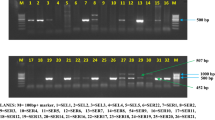Abstract
Trichoderma spp. are used for biocontrol of several plant pathogens. However, their efficient interaction with the host needs to be accompanied by production of secondary metabolites and cell wall-degrading enzymes. Three parameters were evaluated after interaction between four Trichoderma species and plant-pathogenic fungi: Fusarium solani, Rhizoctonia solani and Sclerotinia sclerotiorum. Trichoderma harzianum and T. asperellum were the most effective antagonists against the pathogens. Most of the Trichoderma species produced toxic volatile metabolites, having significant effects on growth and development of the plant pathogens. When these species were grown in liquid cultures with cell walls from these plant pathogens, they produced and secreted β-1,3-glucanase, NAGAse, chitinase, acid phosphatase, acid proteases and alginate lyase.
Similar content being viewed by others
References
Ajith PS, Lakshmidevi N (2010) Effect of volatile and non-volatile compounds from Trichoderma spp. against Colletotrichum capsici incitant of anthracnose on Bell peppers. Nat Sci 8(9):265–269
Almeida FB, Cerqueira FM, Silva RN, Ulhoa CJ (2007) Mycoparasitism studies of Trichoderma harzianum strains against Rhizoctonia solani: evaluation of coiling and hydrolytic enzyme production. Biotechnol Lett 29:1189–1193
Amin F, Razdan VK, Mohid FA, Bhat KA, Banday S (2010) Potential of Trichoderma species as biocontrol agents of soil borne fungal propagules. J Phytol 10:38–41
Baghel RK, Sharma R, Pandey AK (2009) Activity of acid phosphatase in the ectomycorrhizal fungus Cantharellus tropicalis under controlled conditions. J Trop For Sci 21(3):218–222
Bell DK, Wells HD, Markham CR (1982) In vitro antagonism of Trichoderma species against six fungal plant pathogens. Phytopathol 72:379–382
Brunner K, Peterbauer CK, Mach RL, Lorito M, Zeilinger S, Kubicek CP (2003) The Nag1 N-acetylglucosaminidase of Trichoderma atroviride is essential for chitinase induction by chitin and of major relevance to biocontrol. Curr Genet 43(4):289–295
Carvalho DDC, Mello SCM, Lobo-Júnior M, Silva MC (2011) Controle de Fusarium oxysporum f. sp. phaseoli in vitro e em sementes, e promoção do crescimento inicial do feijoeiro comum por Trichoderma harzianum. Trop Plant Pathol 36(1):28–34
De Marco JL, Felix CR (2002) Characterization of a protease produced by a Trichoderma harzianum isolate which controls cocoa plant witches’ broom disease. BMC Biochem 3:1–7
Dubey S, Suresh M, Singh B (2007) Evaluation of Trichoderma species against Fusarium oxysporum f. sp. ciceris for integrated management of chickpea wilt. Biol Control 40:118–127
Feofila EP (2010) The fungal cell wall: modern concepts of its composition and biological function. Microbiology 79(6):723–733
Gruber S, Seidl-Seiboth V (2012) Self and non-self: fungal cell wall degradation in Trichoderma. Microbiology 158:26–34
Hartl L, Zach S, Seidl-Seiboth V (2012) Fungal chitinases: diversity, mechanistic properties and biotechnological potential. Appl Microbiol Biotechnol 93:533–543
Kapil R, Kapoor AS (2005) Management of white rot of pea incited by Sclerotinia sclerotiorum using Trichoderma spp. and biopesticides. Indian Phytopathol 58(1):10–16
Leitão VO, de Melo Lima RC, Vainstein MH, Ulhoa CJ (2010) Purification and characterization of an acid phosphatase from Trichoderma harzianum. Biotechnol Lett 32(8):1083–1088
Lopes FA, Steindorff AS, Geraldine AM, Brandão RS, Monteiro VN, Lobo M Jr, Coelho AS, Ulhoa CJ, Silva RN (2012) Biochemical and metabolic profiles of Trichoderma strains isolated from common bean crops in the Brazilian Cerrado, and potential antagonism against Sclerotinia sclerotiorum. Fungal Biol 116:815–824
Lorito M, Woo SL, Harman GE, Monte E (2010) Translational research on Trichoderma: from ‘omics to the field. Annu Rev Phytopathol 48:395–417
Marcello CM, Steindorff AS, Silva SP, Silva RN, Bataus LAM, Ulhoa CJ (2010) Expression analysis of the exo-β-1,3-glucanase from the mycoparasitic fungus Trichoderma asperellum. Res Microbiol 165:75–81
Mukherjee M, Mukherjee PK, Hoewitz BA, Zachov C, Berg G, Zeilinger S (2012) Trichoderma-plant-pathogen interactions: advances in genetics of biological control. Indian J Microbiol 54:522–529
Ramada MHS, Lopes FAC, Ulhoa CJ, Silva RN (2010) Optimized microplate β-1,3-glucanase assay system for Trichoderma spp. screening. J Microbiol Methods 81:6–10
Reino JL, Guerriero RF, Hernandez-Gala R, Collado IG (2008) Secondary metabolites from species of the biocontrol agent Trichoderma. Phytochem Rev 7:89–123
Rossman AY (2009) The impact of invasive fungi on agricultural ecosystems in the United States. Biol Invasions 11:97–107
Shaigan S, Seraji A, Moghaddam SAM (2008) Identification and investigation on antagonistic effect of Trichoderma spp. on tea seedlings white foot and root rot (Sclerotium rolfsii Sacc.) in vitro condition. Pak J Bio Sci 19:2346–2350
Siddiquee S, Cheong BE, Taslima K, Kausar H, Hasan MM (2012) Separation and identification of volatile compounds from liquid cultures of Trichoderma harzianum by GC-MS using three different capillary columns. J Chromatogr Sci 50:358–367
Singh PS, Gupta V, Kumari P, Kumar M, Reddy CRK, Prasad K, Bhavanath J (2011) Purification and partial characterization of an extracellular alginate lyase from Aspergillus oryzae isolated from brown seaweed. J Appl Phycol 23:755–762
Steindorff AS, Silva RN, Coelho ASG, Noronha EF, Ulhoa CJ (2012) Trichoderma harzianum expressed sequence tags for identification of genes with putative roles in mycoparasitism against F. solani. Biol Control 61(2):134–140
Tolêdo-Souza ED, Lobo-Júnior M, Silveira PM, Café-Filho AC (2009) Interações entre F. solani f. sp. phaseoli e Rhizoctonia solani na severidade da podridão radicular do feijoeiro. Pesquisa Agropecuaria Brasileira 39(1):13–17
Vinale F, Sivasithamparam K, Ghisalberti EL, Marra R, Barbetti MJ, Li H et al (2008) A novel role for Trichoderma secondary metabolites in the interactions with plants. Physiol Mol Plant Pathol 72(80–86):6
Wong TY, Preston LA, Schiller NL (2000) Alginate lyase: review of major sources and enzyme characteristics, structure-function analysis, biological roles, and applications. Annu Rev Microbiol 5:289–340
Yan L, Qian Y (2009) Cloning and heterologous expression of SS10, a subtilisin-like protease displaying antifungal activity from Trichoderma harzianum. FEMS Microbiol Lett 290(1):54–61
Acknowledgments
This work was funded by FINEP (Research and Projects Financing) and the National Council for Scientific and Technological Development (CNPq) and The State of Goiás Research Foundation (FAPEGO). T.F.Q was supported by a scholarship from CNPq. Dr. R. Pogue for reading this manuscript.
Author information
Authors and Affiliations
Corresponding author
Rights and permissions
About this article
Cite this article
Qualhato, T.F., Lopes, F.A.C., Steindorff, A.S. et al. Mycoparasitism studies of Trichoderma species against three phytopathogenic fungi: evaluation of antagonism and hydrolytic enzyme production. Biotechnol Lett 35, 1461–1468 (2013). https://doi.org/10.1007/s10529-013-1225-3
Received:
Accepted:
Published:
Issue Date:
DOI: https://doi.org/10.1007/s10529-013-1225-3




